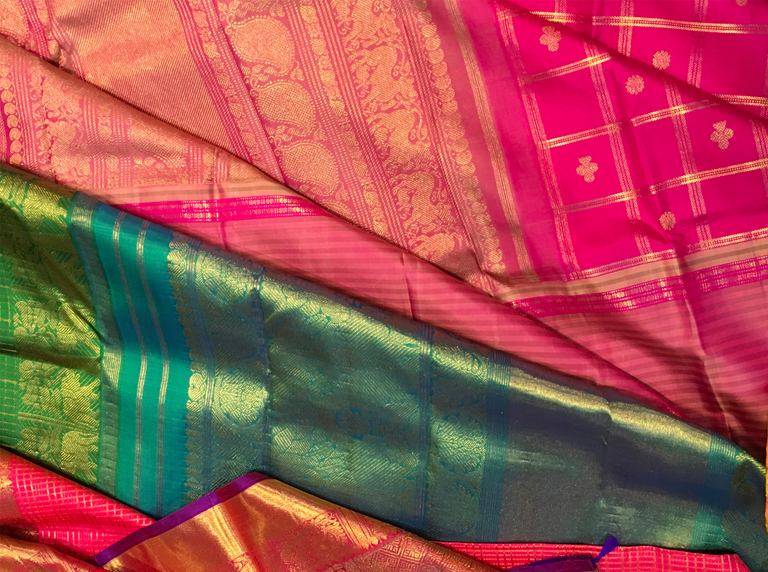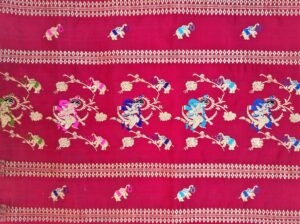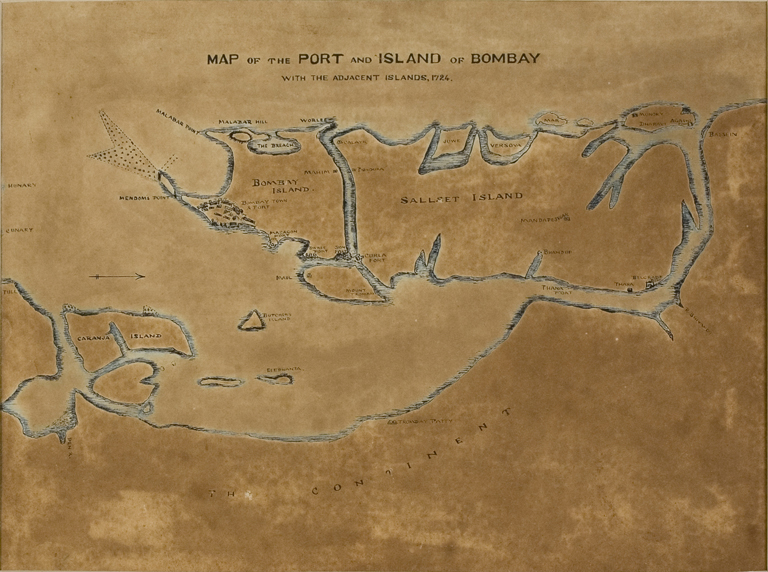Pavithra Muddaya
ABOUT VIMOR
Vimor, a small home store selling handloom sarees, was started in 1974 by Mrs. Chimy Nanjappa and Pavithra Muddaya. Since its inception, Vimor has dedicated itself to reviving and documenting traditional handloom saree motifs, techniques, and oral history. In the past 45 years, Vimor has had tremendous success in training several weavers to produce traditional marketable sarees. A weaver was given hand-holding support through mentorship, designs, color aesthetics, financial credit, and also the strength to grow.
Chimy Nanjappa our Inspiration and founder was the first-ever manager in the State-run Handicrafts Emporium in Bangalore in the late 50s.She was chosen to work at the World’s Fair New York in 1964,1965 and Montreal in1967. Her commitment to working with artisans and promoting textiles had the support of Mrs. Pupal Jayakar and Kamala Devi Chattopadya, the stalwarts of the Handloom and Handicraft movement, who resurrected this sector post-Indian Independence.
The Vimor Handloom Foundation is a brainchild of Vimor legacy and was set up with a vision of empowering weavers through conservation of handlooms, educate citizens on handloom inheritance, research, document, and innovate the environmentally friendly sustainable product.
The Living Museum of Textiles celebrates the contribution of handloom weavers to our country’s textile heritage.
A Saree, we believe is every Indian’s inheritance. We bring this exhibition for you to experience our textile legacy. These are forgotten and unconventional designs from all across the country with personal stories of the owner. These Sarees have been donated to Vimor very graciously.
Pavithra Muddaya is a senior designer having decades of experience in the revival of traditional designs. She is the managing trustee of the Vimor Handloom Foundation and the Museum of living textiles is her brainchild. These are personal conclusions arrived at regarding the designs from Pavithra’s 45 years of experience in the handloom textile industry.
BRIDGING CULTURES
In the present times, the foundation felt it was necessary to celebrate textile culture in its totality within our museum collection. Bridging Cultures Exhibition is a sure way to understand the commonly shared stories across geographical regions and celebrate a spirit of knowledge sharing through the woven fabric.
The exhibition showcases unusual woven motifs used as a communicative approach to bridge cultural and geographical differences. The sarees portray cross-cultural influences in the designs, motifs, and weaving techniques due to migrations and trade.
The sarees exhibited in the Bridging Cultures exhibition are a part of the Vimor private collection.
The original technique used in most of these exhibition sarees was called the ‘Adai’ – A special loom setting practiced in South India before the advent of the jacquard looms. This is a system where a design is tied by a series of knots on a cord, followed from a drawing on a graph sheet. This is then mounted on an attachment to the main loom creating patterns by raising and lowering particular yarns of the warp for the shuttle to pass through.
GRAMOPHONE – AEROPLANE- CAR

Origin: Unknown
Age: 20th cc
Material: Mulberry Silk
Design Specialty:
This is one of our special saree in our museum collection.It establishes the role of the weaver as a great communicator who documented people’s experiences of things they encountered.
The motifs of cars and Bi-planes are very unusual but gramophones were pretty common. The detailing of different parts of the car is to be observed.
The binding technique works well to create spacing between the door, windows & other parts. The simple design techniques have been used by the weaver to share new products seen in the cities with his rural brothers.
GANDUBERANDA
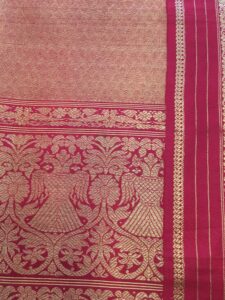
Origin: Karnataka/ Tamil Nadu- India
Age: 20th cc
Material: Mulberry Silk
Design Specialty:
The Ganduberanda is a mythical bird that represents strength and power. The double-headed eagle design appears in many versions across history from the Persians, Greeks, Romans to Taxila to Vijayanagar.It has been the royal insignia of the Wadiyar Kingdom of Mysore and has been adapted as Karnataka’s state emblem.
It is woven using a 3-shuttle technique mainly to create a sharp contrast. The border is interesting, as there is no repetition or similarity between the pallu and border. The original technique was the Adai. The binding was incorporated in the design as a necessity but also enhances the textural look. Imagination is a creative expression of the weaver’s personal understanding of these myths.
NANJAPPA -SIMHASANA
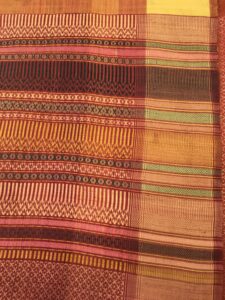
Origin: Tamil Nadu, India
Age: 20th cc
Material: Silk
Design Specialty:
This was also called Simhansana by the trader who sold this piece. Apart from the historical political and cultural influence Southern India had on South East Asian countries,trade existed with those regions.
The original saree was lent to the Government of India,for the Vishwakarma Exhibitions / Festival of India in England,France, and Moscow in the early 1980s
Mr.Marthand Singh who curated the festival named this Bangalore Nanjappa Saree as a tribute to Chimy Nanjappa as its origin was not clear.
The beauty of this design lies in the basic design of the weave; it is a diamond that runs through the whole body. It varies in size and shapes through the border & pallu [halved, quartered, smaller adaptations, and even elongated].
POOJA SILK IKKAT

Origin: Molkalmuru Region, Karnataka, India
Material: Mulberry Silk
Age: 20th cc
Design Specialty:
The name Pooja came to stay as the borders resembled those of the Angavastra( the shoulder cloth worn with a dhoti /sarong by the priestly class). Years ago in the mid-1970s there was no way of determining where this saree was woven because Ikkat (tie & dye) dyeing and Jamdani (weft interlock) technique together were not prevalent anywhere in Karnataka or Tamil Nadu as far as we knew then. A high level of skill was required to do these techniques.
It was only on Pavithra’s research on Molkalmuru textiles of Karnataka India that a lot of facts were unearthed through oral histories. This allowed us to study the impact of the migrations among weaving communities leading to design development.
This design revival has been developed first by Vimor for 44 years with weavers from different regions of the south. Today it has been in continuous products for 44 years, impacting hundreds of weavers’ livelihood independent of Vimor. This, Pavithra believes is the foundation’s contribution to using design for a larger cause.
The pooja saree has been recreated and revived in many versions continuously for 43 years first by Vimor impacting many weavers across regions. This is an example of being inspired by the original textile to create livelihood opportunities for many weavers to succeed.
The silk yarn was dyed using natural dyes and was not highly twisted. The body has double Muthu lines [dotted lines] in perfect squares. The center of each square had a tiny tie and dye design, which resembled a dash/hyphen.
The border had a “navillu kannu” [peacock eye in Kannada], the pallu is elaborate with the “khalasha” which is a motif of a coconut sitting on mango leaves atop a small pot of water [traditionally used in Hindu ceremonies]. The last bit of the Pallu has minute birds in the Jamdhani (weft interlock) technique.
CIRCUS ANIMALS MOTIF

Origin: South India, probably Tamil Nadu
Material:Mulberry Silk and Gold thread
Age: 20th cc
Design Speciality:
This is the first time Pavithra has seen this motif in all her years of work in the design space. In a way, it idealizes the weaver’s attempt to show peaceful co-existence among all of God’s creations.
Observe the unusual motif depicting an elephant and a tiger riding a cycle. This was a common act in circuses till 1970 where the ringmaster guided these animals riding on tricycles for a thrilled audience.
There were two weavers who wove this saree based on the design. The depiction of the elephant at a slanted angle on the cycle speaks about the artist in the weaver to weave the animals as they look in the circus. The weaver has pushed himself to weave these real-life scenes to share with his village folks. His way of sharing knowledge and technique.
FLYING APSARA
Origin: Dodaballapur, Karnataka India
Material: Mulberry Silk
Age: 20th cc
Design Speciality:
India has many mythical oral stories passed from generation to generation. In this saree, the weaver uses his imagination to transport the wearer to visualize lord Indra’s (a God in the Indian pantheon) abode in the skies. In Indian mythology and stories, there are always descriptions of flying nymphs, called Apsaras who support the major Gods. They were beautiful, talented dancers who were coveted.
Lord Indra was the ruler of the skies and the elephant was his vehicle, so we see the flying Apsaras with the elephants also flying.
Dodabalapur is very close to the city of Bangalore in Karnataka India and was a famous silk weaving center, till the power looms replaced the handloom. The sarees in these areas were woven with thinner silk. This sarees has colored threads woven along with the gold motifs, called meenawork in weaving terms.
VILLAGE GIRLS PLAYING

Origin: TamilNadu/ Karnataka, India
Material: Mulberry Silk and Gold thread
Age: 20th cc
Design Speciality:
This saree shows two village girls spinning, holding hands. This picture of two young girls spinning holding each other’s hands crossed was a very common play before the age of mechanized toys.
This scene is woven to show the simple playful joys before the age of electronic and mechanical entertainment took over our lives.
The weaver’s mastery of details is amazing in weaving every small detail. Appreciate the girl’s skirts billowing in the wind, her braids flying with the momentum, the crossed hands, the details of her skirt and feet and face.
Again, appreciate the weaver’s role in reminding people of unnecessary consumerism.
TIGER AND PEACOCK PLAYING
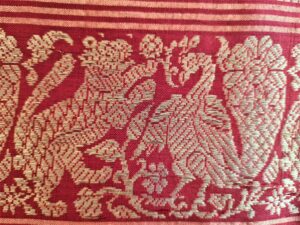
Origin: Tamil Nadu, India
Material: Mulberry Silk and Gold thread
Age: 20th cc
Design Speciality:
This design was unusual in that we have seen tigers crouching on their prey or just shown standing in woven fabric. Pavithra has never seen a tiger befriending a peacock. The playful mood is evident from its stance with the submissive peacock. The Indian weaver could translate every imaginable fantasy into weaves.
This is the first time Pavithra has seen this motif in all hert years of work in the design space. In a way, it idealizes the weaver’s attempt to show peaceful co-existence among all of God’s creations.
GRAMOPHONE MOTIF

Origin: Karnataka India
Age: 20th cc
Material: Mulberry Silk and Gold thread
Design Speciality:
The Gramaphone motif was not a common design. Many years later in the course of her work, Pavithra came across similar handwoven gramophone motifs in sarees. This could have been a trend to use these motifs in sarees as she has seen them in sarees across Benaras, Tamil Nadu, and Karnataka.
It establishes the role of the weaver as a great communicator who documented people’s experiences of things they encountered.
The timeline of these products is difficult to fix due to a lack of documentation. The use of new products in weaving can only mean that the weaver had the freedom to create a design vocabulary to include mechanical inventions.
GLOBAL PEACE

Origin: Tamil Nadu, India
Age: 20th cc
Material: Mulberry Silk and Gold thread
Design Specialty:
An amazing saree woven to celebrate Indian independence, observe the globe at the center on our national flower- the lotus, with the peace doves flying from the Parliament House, with our new independent flag. Respect the unlettered weavers’ brilliance of understanding world peace. This is the magic of Indian silk motifs and textiles that we can connect ourselves to the entire world. In India we call this ‘Vasudhaiva Kutumbakam’- The world is our family.
MANIPURI PALLU
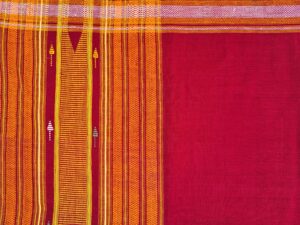
Origin: Tamil Nadu, India
Age: 20th cc
Material: Cotton
Design Speciality:
45 years ago when Vimor acquired this saree Pavithra named it Manipuri as the design resembled the North Eastern Indian motif.
The pallu( the outer end of the saree which is draped across the woman’s shoulder) arrow motifs are very similar to the North Eastern weaves. The border has a very typical south Indian design.It is amazing to see this saree which had a coming together of design elements from two geographically distant regions of India.
The original was woven in 20’s count cotton in red color. The border diamonds were woven using the dobby (designs on this loom are punched on wooden strips and interconnected with a chain to create a circular movement attached to the main loom) method and the arrow designs were hand-picked. The weaver has cleverly used the dotted lines and woven them closely to create a rich effect.
Acknowledgments-
-All the handloom weavers across India for keeping this craft alive.
-Dr. Madhuvanti Ghose- Alsdorf Associate Curator of Indian, Southeast Asian, and Himalayan Art, Arts of Asia, The Art Institute of Chicago, for her constant guidance and encouragement.
-Dr. Vandana- Director (Center for Art & Archaeology, American Institute of Indian Studies), for her support always.
-Stuti Gandhi- Research Associate (Center for Art & Archaeology, American Institute of Indian Studies), for her great patience in guiding me through the entire program.
-Devika Kembhavi- designer, without whom this would not have been possible.
-Arup Nanjappa- for his support.
-AIIS, for facilitating and conducting these fabulous workshops.
